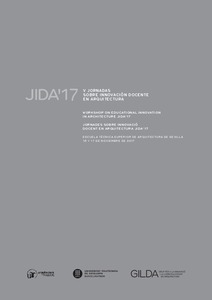Creatividad y pensamiento crítico

Visualitza/Obre
Cita com:
hdl:2117/109610
Tipus de documentText en actes de congrés
Data publicació2017-11
EditorUniversitat Politècnica de Catalunya. Iniciativa Digital Politècnica
Grup per a la Innovació i la Logística Docent en l'Arquitectura (GILDA)
Grup per a la Innovació i la Logística Docent en l'Arquitectura (GILDA)
Condicions d'accésAccés obert
Llevat que s'hi indiqui el contrari, els
continguts d'aquesta obra estan subjectes a la llicència de Creative Commons
:
Reconeixement-NoComercial-SenseObraDerivada 4.0 Internacional
Abstract
La comunicación presenta la asignatura de Composición II, a través de dos acciones: las presentaciones en grupo (happening), y la redacción del artículo crítico individual. La libertad en ambos ejercicios es alta y el grado de respuesta muy bueno.En el happening se presenta el objeto de estudio de una forma creativa, buscando el debate y la participación: maquetas, muebles, detalles, murales, videos, instalaciones, performances, juegos, etc. El artículo crítico pretende, con las palabras e imágenes justas, aportar una nueva mirada sobre el objeto estudiado. El estudiante propone tema y formato, de redacción y de presentación. La evaluación se produce por procesos naturales de interacción con los alumnos. El seguimiento de cada uno de los estudiantes, de la dinámica de los grupos, de la asistencia y la participación, son puntales de la acción del profesorado, que cuenta siempre con intervenciones de profesores invitados, para fomentar la diversidad del punto de vista en el conocimiento de la disciplina. The communication presents the subject of Composition II, through two actions: the presentations in group (happening), and the writing of the individual critical article. The freedom in both exercises is high and the degree of response very good.In the happening, the case of study is presented in a creative way, looking for debate and participation: models, furniture, details, murals, videos, installations, performances, games, etc. The critical article aims, with few words and images, to bring a new look on the object studied. The student proposes the topic and the format of writing and presentation. The evaluation is produced by natural processes of interaction with the students. The follow-up of each student, the dynamics of the groups, the attendance and the participation, are props of the action of the prossessors, always counting on interventions of invited lecturers, to foment the diversity of the point of view in the knowledge of the discipline.
CitacióMartínez Duran, Anna; Lois Alcázar, Sergi. Creatividad y pensamiento crítico. A: Garcia Escudero, Daniel; Bardí Milà, Berta, eds. "V Jornadas sobre Innovación Docente en Arquitectura (JIDA'17), Escuela Técnica Superior de Arquitectura de Sevilla, 16 y 17 de Noviembre de 2017". Barcelona: UPC IDP; GILDA, 2017. ISBN: 978-84-9880-681-6 (UPC), p. 456-468.
Dipòsit legalB 9090-2014
ISBN978-84-9880-681-6
ISSN2462-571X
Referències
- BERGER, J. (2015). Para entender la fotografia. Barcelona: Gustavo Gili.
- BORGES, J.L. (2008). Pierre Menard, autor del Quijote. En Ficciones. Madrid: Alianza Editorial.
- DE LA SOTA, A. (1989). Alejandro de la Sota. Madrid: Pronaos.
- DE LA SOTA, A. (2002). Escritos. Barcelona: Gustavo Gili.
- EHRENZWEIG, A. (1973). El orden oculto del arte. Barcelona: Labor.
- FREDERICK, M. (2007). 101 Things I learned in Architecture School. Cambridge (MASS): The MIT Press.
- LLINÁS, J. Arquitectura sin trabajo. En ÁBALOS, I., LLINÁS, J., PUENTE, M. (2009). Alejandro de la Sota. Barcelona: Arquia.
- MARTÍ, C. Prólogo. En VACCHINI, L. (2009). Obras maestras. Barcelona: Gustavo Gili.
- MARTÍNEZ DURAN, A. (2008). La casa del arquitecto. Tesis Doctoral. Barcelona: Universitat Politécnica de Catalunya, <http://www.tesisenred.net/handle/10803/53596> [Consulta: 9 septiembre 2017]
- MARTÍNEZ DURAN, A. (2008). Introducción a la arquitectura. Barcelona: Universitat Ramon Llull.
- MARTÍNEZ DURAN, A. (2011). “Taller de Maquetas. Termas de Vals”, Aristos Campus Mundus. Universitat Ramon Llull. En Jornadas Interuniversitarias de Innovación Docente. Barcelona: Actas del Congreso.
- MARTÍNEZ DURAN, A. (2013). Intervención en tribunal de tesis de: DE RENTERIA, I. Detalles en la arquitectura de Jose Antonio Coderch. Barcelona: Universitat Ramon Lllull.
- MARTÍNEZ DURAN, A. LOIS ALCÁZAR, S. (2014). “Venecia. Ciudad invisible”. Expresión Gráfica Arquitectónica. En El dibujo de viaje de los arquitectos. Las Palmas: Actas del Congreso. http://15ega.ulpgc.es/files/libro/seccion03/0313_MART%C3%8DNEZ%20DUR%C3%81N.pdf
- MESTRE, X. (2014). Autodidactas. Barcelona. Diagonal (Núm. 38) http://www.revistadiagonal.com/v2/articles/mirando-hacia-atras-con-ira/autodidactas/
- MIES VAN DER ROHE, L. (1982). Escritos, diálogos y discursos. Madrid: COAT.
- NAYDLER, J. ed (1996). Goethe y la ciencia. Madrid: Siruela.
- ORTEGA Y GASSET, J. (1985). Meditaciones del Quijote. Ideas sobre la novela. Madrid: Espasa Calpe.
- ORTEGA Y GASSET, J. (1988). El tema de nuestro tiempo. Madrid: Espasa Calpe.
- PALLASMAA, J. (2012). La mano que piensa. Barcelona: Gustavo Gili.
- PARENTE, L. (2013). Ortega y Gasset e la “vital curiosidad” filosófica. Milano-Udine: Mímesis.
- PIÑON, H. (2005). El proyecto como (re)construcción. Barcelona: UPC.
| Fitxers | Descripció | Mida | Format | Visualitza |
|---|---|---|---|---|
| 5251-2987-1-PB.pdf | 1,623Mb | Visualitza/Obre |


